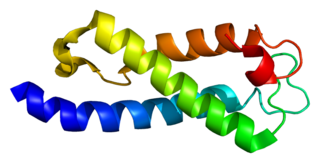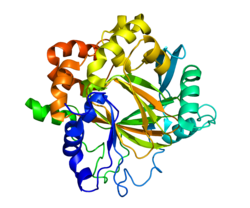
In genetics and developmental biology, somatic cell nuclear transfer (SCNT) is a laboratory strategy for creating a viable embryo from a body cell and an egg cell. The technique consists of taking a denucleated oocyte and implanting a donor nucleus from a somatic (body) cell. It is used in both therapeutic and reproductive cloning. In 1996, Dolly the sheep became famous for being the first successful case of the reproductive cloning of a mammal. In January 2018, a team of scientists in Shanghai announced the successful cloning of two female crab-eating macaques from foetal nuclei.
Demethylases are enzymes that remove methyl (CH3) groups from nucleic acids, proteins (particularly histones), and other molecules. Demethylases are important epigenetic proteins, as they are responsible for transcriptional regulation of the genome by controlling the methylation of DNA and histones, and by extension, the chromatin state at specific gene loci.

Lysine-specific histone demethylase 1A (LSD1) also known as lysine (K)-specific demethylase 1A (KDM1A) is a protein that in humans is encoded by the KDM1A gene. LSD1 is a flavin-dependent monoamine oxidase, which can demethylate mono- and di-methylated lysines, specifically histone 3, lysine 4 (H3K4). Other reported methylated lysine substrates such as histone H3K9 and TP53 have not been biochemically validated. This enzyme plays a critical role in oocyte growth, embryogenesis, hematopoiesis and tissue-specific differentiation. LSD1 was the first histone demethylase to be discovered though more than 30 have since been described.

Histone-lysine N-methyltransferase 2A, also known as acute lymphoblastic leukemia 1 (ALL-1), myeloid/lymphoid or mixed-lineage leukemia1 (MLL1), or zinc finger protein HRX (HRX), is an enzyme that in humans is encoded by the KMT2A gene.

Polycomb protein SUZ12 is a protein that in humans is encoded by the SUZ12 gene.

C-terminal-binding protein 2 also known as CtBP2 is a protein that in humans is encoded by the CTBP2 gene.

Lysine-specific demethylase 5A is an enzyme that in humans is encoded by the KDM5A gene.

Lysine-specific demethylase 5D is an enzyme that in humans is encoded by the KDM5D gene. KDM5D belongs to the alpha-ketoglutarate-dependent hydroxylases superfamily.

Lysine-specific demethylase 4A is an enzyme that in humans is encoded by the KDM4A gene.

Inhibitor of growth protein 2 is a protein that in humans is encoded by the ING2 gene.

Lysine-specific demethylase 2A (KDM2A) also known as F-box and leucine-rich repeat protein 11 (FBXL11) is an enzyme that in humans is encoded by the KDM2A gene. KDM2A is a member of the superfamily of alpha-ketoglutarate-dependent hydroxylases, which are non-haem iron-containing proteins.

SET domain containing 2 is an enzyme that in humans is encoded by the SETD2 gene.

Lysine-specific demethylase 3B is an enzyme that in humans is encoded by the KDM3B gene. KDM3B belongs to the alpha-ketoglutarate-dependent hydroxylase superfamily.

Histone-lysine N-methyltransferase 2D (KMT2D), also known as MLL4 and sometimes MLL2 in humans and Mll4 in mice, is a major mammalian histone H3 lysine 4 (H3K4) mono-methyltransferase. It is part of a family of six Set1-like H3K4 methyltransferases that also contains KMT2A, KMT2B, KMT2C, KMT2F, and KMT2G.

Lysine-specific demethylase 5B also known as histone demethylase JARID1B is a demethylase enzyme that in humans is encoded by the KDM5B gene. JARID1B belongs to the alpha-ketoglutarate-dependent hydroxylase superfamily.

Lysine-specific demethylase 4B is an enzyme that in humans is encoded by the KDM4B gene. KDM4B belongs to the alpha-ketoglutarate-dependent hydroxylase superfamily.

Lysine-specific demethylase 4C is an enzyme that in humans is encoded by the KDM4C gene.

The human KDM2B gene encodes the protein lysine (K)-specific demethylase 2B.

Lysine demethylase 3A is a protein that in humans is encoded by the KDM3A gene.

Yi Zhang is a Chinese-American biochemist who specializes in the fields of epigenetics, chromatin, and developmental reprogramming. He is a Fred Rosen Professor of Pediatrics and professor of genetics at Harvard Medical School, a senior investigator of Program in Cellular and Molecular Medicine at Boston Children's Hospital, and an investigator of the Howard Hughes Medical Institute. He is also an associate member of the Harvard Stem Cell Institute, as well as the Broad Institute of MIT and Harvard. He is best known for his discovery of several classes of epigenetic enzymes and the identification of epigenetic barriers of SCNT cloning.






















